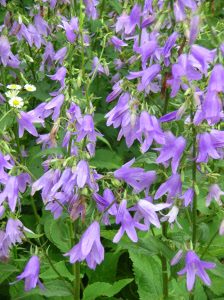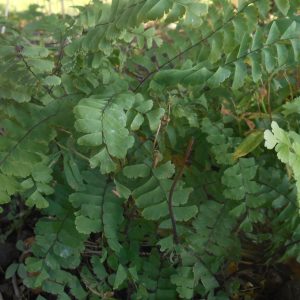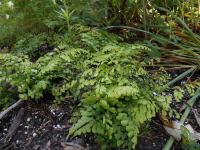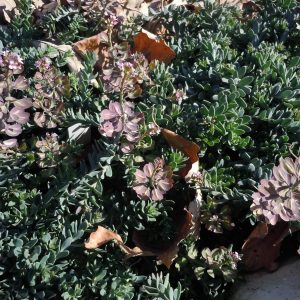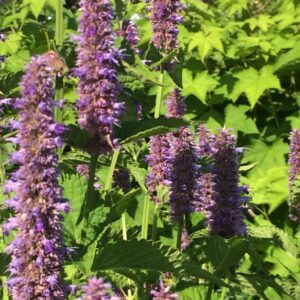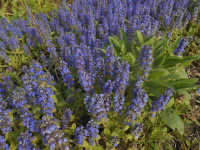Perennials & Biennials
Showing 9–16 of 511 results
-
Adenophora lilifolia Ladybells Z 3-8
Fragrant, flared, drooping bluebells.
Fragrant, flared, drooping bluebells in midsummer, July and August
Size: 18" x 12" spreading
Care: full sun to part shade in moist well-drained soil
Native: central Europe east to SiberiaAdenophora is Greek from aden meaning “gland” and phore meaning “to bear.” Japanese cultivated this for edible root. First named as a Campanula and described by Johann Amman in Stirpium rariorum (1739) from a pressed specimen collected in Tartarian Siberia. Stirpium rariorum included more than 285 species collected in Russia by Johann Heinzelmann, Johann Georg Gmelin, and Daniel Gottlieb Messerschmidt. Linnaeus changed the name to Adenophora in 1753.
-
Adiantum pedatum Maidenhair fern Z 4-9
Grown for its delicate-appearing leaflets arranged in rows. One of internationally known garden designer Piet Oudolf’s 100 “MUST HAVE” plants, Gardens Illustrated 94 (2013)
OUT OF STOCK
Grown for its delicate-appearing leaflets arranged in rows. One of internationally known garden designer Piet Oudolf’s 100 “MUST HAVE” plants, Gardens Illustrated 94 (2013)
Size: 12-24”x 12”
Care: Shade in moist soil
Native: all parts of No. America including Wisconsin
Awards: England’s Royal Horticultural Society Award of Merit.Cherokee made a tea from this for flu, fever, and rheumatism, paralysis and asthma. Native Americans used stem to make a hair wash and applied a topical poultice of masticated fronds to wounds to stop bleeding. 1st described by French botanist Cornut in 1635. Introduced to gardens in 1635 from Canada where it grew in “such quantities that the French sent it from thence in package for other goods and the apothecaries at Paris use it for (another Maidenhair) in all their compositions in which that is ordered.” Philip Miller (1768). Tradescant the Younger introduced it to English gardens in 1638 when he sent it from Virginia Colony to London. English herbalist Nicholas Culpepper claimed it as “a good remedy for coughs, asthmas, pleurisy, etc., and on account of being a gentle diuretic, also in jaundice, gravel and other impurities of the kidneys.” Father of mixed perennial gardens, William Robinson, called this “elegant…unquestionably one of the most distinct and beautiful of the hardy ferns.” The Garden 1876.
-
Adiantum venustum Himalayan maidenhair fern Z 5-8
Black stems hold triangular, delicate, lacy fronds of tiny leaflets
OUT OF STOCK
Black stems hold triangular, delicate, lacy fronds of tiny leaflets. Favorite short fern.
Size: 6" x 12", slow spreader
Care: part or light shade in moist well-drained soil but tolerates any soil
Native: China and Himalayan Mountains
Awards: Great Plant Pick from Elisabeth Cary Miller Botanic Garden & Royal Horticultural Society Award of Garden MeritAdiantum is from Greek adiantos, “unwettable” because its fronds repel water. Venustum means attractive in Latin. (We think it should be “venustumest” for most attractive.) Collected for gardens by 1841.
-
Adlumia fungosa Allegheny vine, Climbing fumitory, Bleeding heart vine Biennial Z 4-8
Dangling pink to white Bleeding heart-like flowers bloom all summer, June-September. Fern-like foliage on twining stems
OUT OF STOCK
Dangling pink to white Bleeding heart-like flowers bloom all summer, June-September. Fern-like foliage on twining stems
Size: 6-10’ x 12”
Care: part shade to shade in moist to moist well-drained, acidic soil
Native: Nova Scotia to No. Carolina west to Minnesota Wisconsin native status-special concern
Wildlife Value: attracts bumblebees1st described in 1789 (Aiton, Vol. 3 Hortus Kewensis).
-
Aethionema cordifolia Lebanon stonecress Persian candytuft Z 4-8
Short subshrub with lovely, tiny blue-green leaves on upright stems with terminal clusters of pale pink blooms in spring. Perfect for rock gardens and front of the border.
OUT OF STOCK
Aethionema cordifolia Lebanon stonecress, Persian candytuft Z 4-8
Short subshrub with lovely, tiny blue-green leaves on upright stems with terminal clusters of pale pink blooms in spring. Perfect for rock gardens and front of the border.Size: 6-8” x 12-15”
Care: sun in well-drained soil. Sheer back after blooming to keep compact and rebloom.
Native: Lebanon and possibly Caucasus on chalky summits.Collected before 1841. Foster: “…when planted in quantity does wonders for mass effect in the rock garden or alpine lawn.” January 1876 issue of The Garden called these “very attractive dwarf rock garden plants.” Aethionema from aitho meaning scorch and nema for filament.
-
Aethionema grandiflorum Persian stonecress Z 5-8
Bushy, low growing perennial with blue-green leaves and spikes of fragrant pink to lavender flowers, June-July
OUT OF STOCK
Bushy, low growing perennial with blue-green leaves and spikes of fragrant pink to lavender flowers, June-July
Size: 6-12” x 12-18”
Care: full sun in well-drained soil. Drought tolerant.
Native: Iran, Iraq, Caucasus, Turkey
Wildlife Value: attracts honeybees & other pollinators, Deer & Rabbit resistant.
Awards: Award of Garden Merit from the Royal Horticultural SocietyShort-lived perennial, but self-seeds where happy. Described in 1849 by Pierre Edmond Boissier and Rudolph Friedrich Hohenacker.
-
Agastache foeniculum Anise hyssop Z 4-8
Purplish-blue spikes from July to October. Fragrant foliage.
Purplish-blue spikes from July to October. Fragrant foliage.
Size: 2-3' x 12"
Care: Full sun in well-drained soil, heat and drought tolerant.
Native: North America, Wisconsin native.
Wildlife Value: Skipper butterflies and Rusty patched Bumble Bees love Anise hyssop’s nectar, deer resistant.The name Agastache is from Greek agan and stachys meaning much like an ear of wheat referring to the shape of the flower spike. Anise hyssop leaves were used by American Americans of the Missouri River region to make tea and as a sweetener in cooking. For Cheyenne it relieved chest pain due to coughing or to a dispirited heart. Listed as an aromatic herb in McMahon’s 1805 book.
-
Ajuga genevensis Geneva Bugle Z 4-9
True blue 6” spikes in spring and early summer
Ajuga genevensis Geneva Bugle Z 4-9
True blue 6” spikes in spring and early summer. Great groundcover.Size: 6” x 12”
Care: full sun to shade in well-drained to moist well-drained soil
Native: Europe
Wildlife Value: Tolerates foot traffic. Deer and rabbit resistant.William Robinson, father of the mixed perennial garden, called this “among the best.” (1933). In gardens before 1753.

